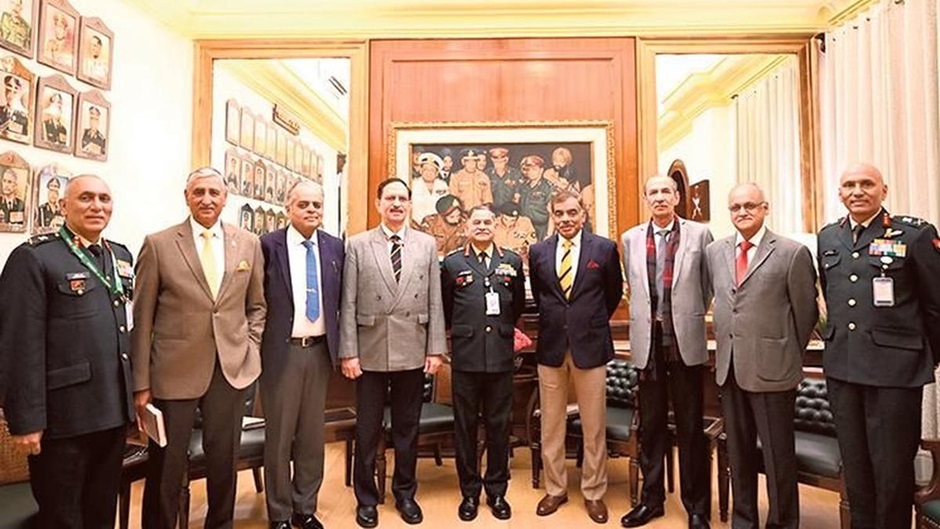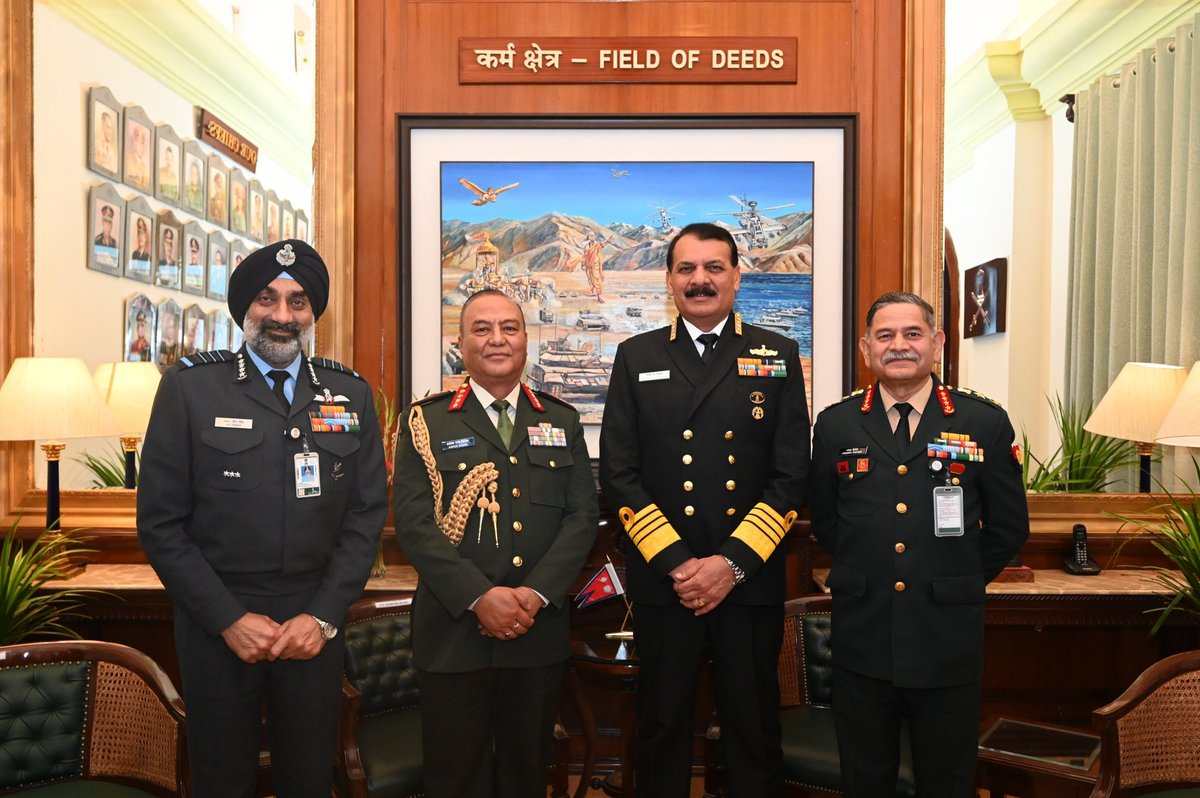- Courses
- GS Full Course 1 Year
- GS Full Course 2 Year
- GS Full Course 3 Year
- GS Full Course Till Selection
- Online Program
- GS Recorded Course
- NCERT (Recorded 500+ Hours)
- Polity Recorded Course
- Geography Recorded Course
- Economy Recorded Course
- AMAC Recorded Course
- Modern India, Post Independence & World History
- Environment Recoded Course
- Governance Recoded Course
- Science & Tech. Recoded Course
- International Relations and Internal Security Recorded Course
- Disaster Management Module Course
- Ethics Recoded Course
- Essay Recoded Course
- Current Affairs Recoded Course
- CSAT
- 5 LAYERED ARJUNA Mentorship
- Public Administration Optional
- ABOUT US
- OUR TOPPERS
- TEST SERIES
- FREE STUDY MATERIAL
- VIDEOS
- CONTACT US
Painting on 1971 Surrender Replaced in Army Chief’s Lounge, Veterans Miffed
Painting on 1971 Surrender Replaced in Army Chief’s Lounge, Veterans Miffed

In December 2024, The replacement of a historic 1971 surrender painting in the Army Chief’s lounge led to a controversy among Indian military veterans.
- The painting that showed the 1971 surrender in the Bangladesh war has been replaced by a new artwork (Karam Kshetra – Field of Deeds).
- This has led to disagreement, as the original painting symbolized India’s important military victory in the creation of Bangladesh.
- The new painting, while artistic, draws on Indian mythology and philosophy, which has upset some veterans.
The New Painting:
- Title: Karam Kshetra – Field of Deeds
- Artist: Lt. Col. Thomas Jacob, from the 28 Madras Regiment.
- Description of the Painting:
- The painting shows the Indian Army as a protector of righteousness (Dharma), fighting not just to defend the country, but to protect justice and national values.
- It includes images of:
- Snow-capped mountains and the Pangong Tso lake in Eastern Ladakh, showing the Army's presence in strategic areas.
- Mythological figures like Garuda (the mythical bird), Krishna’s chariot, and Chanakya (an ancient Indian strategist).
- Modern military equipment such as tanks, all-terrain vehicles, helicopters, and boats.
- The painting aims to show the Army as a modern, well-equipped force, capable of defending the nation in today’s world.
Philosophical Themes:
- The painting links the Army to India’s ancient wisdom, including teachings from the Mahabharata and the strategies of Chanakya.
- It suggests that the Army’s role is not just to defend but also to uphold justice and moral duty, as seen in ancient Indian philosophy.
- The painting is part of a larger effort within the Army to combine modern military strategies with India’s rich cultural and philosophical heritage.
Key Themes of the New Painting:
- Technological Growth: The artwork highlights how the Indian Army has become a modern force, using the latest technology and equipment.
- Preparedness and Resolve: It emphasizes that the Army is always ready to face challenges and defend the nation.
- Legacy of Sacrifice: The painting honors the Army’s values of discipline, bravery, and its willingness to sacrifice for the country.
The Iconic 1971 Surrender Photo:
- Historical Importance:
- The previous painting depicted the 1971 surrender when Lt. Gen. A.A.K. Niazi of the Pakistani Army signed the surrender document before Lt. Gen. Jagjit Singh Aurora of the Indian Army in Dacca (now Dhaka).
- This marked the surrender of 90,000 Pakistani soldiers and the creation of Bangladesh.
- The 1971 victory was India’s first major military success after independence and was a turning point in India’s history.
- The image symbolized India’s military strength and unity, and was considered a proud moment for the country.
Veterans’ Reaction to the Change:
The replacement of the 1971 surrender photo with the new painting has caused a reaction among veterans. Many feel that replacing a historical achievement with symbolic, mythological images weakens the recognition of real military success.
- Lt. Gen. H.S. Panag (Retd.):
- A former Northern Army Commander, Lt. Gen. Panag expressed his unhappiness with the change.
- He felt that the 1971 surrender photo was an important reminder of India’s first major military victory in 1000 years.
- He criticized the shift, suggesting that it was a mistake to focus on mythology and ancient stories rather than celebrating real military accomplishments.
- Air Vice Marshal Manmohan Bahadur (Retd.):
- Bahadur also questioned the decision to replace the 1971 surrender photo, saying it represented one of the most important moments in Indian military history.
- He felt that the new painting, while visually appealing, didn’t have the same historical meaning and might not inspire future soldiers the way the 1971 image did.
Main Points of Disagreement:
- History vs. Symbolism: Veterans believe that the 1971 victory was a real military achievement and should be honored, while the new painting, though beautiful, focuses more on symbolism than on actual military history.
- Mythology vs. Military Realities: The new painting includes mythological figures like Krishna and Chanakya, which some veterans think distracts from celebrating India’s military accomplishments.
- Honoring Real Victories: The veterans argue that the 1971 surrender was a significant moment that should be remembered and celebrated, rather than being replaced by a painting focused on philosophy and mythology.
What Happened to the Old Painting?
- The fate of the original 1971 surrender photo is unclear.
- It has not been mentioned where the photo was moved after it was taken down from the Army Chief’s lounge.
- This has led to questions about why the change was made.
Conclusion:
The replacement of the 1971 surrender photo with the new painting Karam Kshetra – Field of Deeds has caused debate among Indian military veterans. While the new painting seeks to highlight the modern Army’s strength and philosophical roots, many veterans feel it undermines the importance of the 1971 military victory—one of the most significant moments in India’s military history. The controversy reflects a broader discussion about how the Indian military should honor its past: by celebrating military victories or by focusing on philosophy and mythology.




